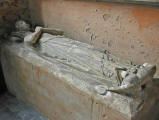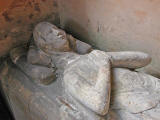| Swaton,
Lincolnshire - St Michael Church 13th century Click on photos to enlarge |
||||
 |
||||
West |
||||
 |
 |
 |
 |
 |
East |
Tower |
Chancel, north side |
Chancel, east window |
South side, nave & transept |
|
In counties less rich in ecclesiastical architecture Swaton would be outstanding. It is a stately cruciform church, ashlar-faced except for the rubble-stone chancel and the lower parts of the tower. ... Externally the story is as follows. E.E. (Early English - early C13) crossing tower with twin bell-openings having an almond-shape in plate tracery. The tower was heightened later, but never received a spire. The chancel is very patently E.E. Separate lancet windows. Hoodmoulds on heads or stiff-leaf. To the E no more than a two-light window. This has bar tracery, a foiled circle, i.e. is later than the crossing tower. But the shafts still have stiff-leaf capitals. Dec (Decorated) nave and aisles with reticulated tracery, very consistent. The aisles are embattled. ... The S transept was altered in the early C18. |
||||

 |
||||
|
Interior. The nave and the aisles are the most impressive part of the church ... Three bays, but as high and as wide as if they belonged to a cathedral. Quatrefoil piers with the foils more than semicircular and small hollows in the diagonals. |
||||



 |
||||
|
The earliest evidence is a fragment of chevron moulding at the E end of the N arcade (i.e. Norman). ... The E wall has shafts with rings to the windows. Pretty details. ... The crossing towers ought to be E.E. (see the tower outside) but were redone Dec. Shafts with fillets, polygonal abaci, double-chamfered arches. ... |
||||
 |


 |
|||
|
Painting. Remains of a wheel (of fortune?) on the S aisle E wall. It probably extended on plasterwork above and below and only remains on some stonework in the wall. This stonework appears to have been a temporary flying buttress supporting the Early English tower when the surrounding structure was rebuilt in the 14th century. |
Font. Octagonal,
with diapering all over. Ball-flower on the underside, i.e. Dec too. |
|||

 |
||||
|
Monument. Late C13 effigy of a lady and a sleeping dog (N aisle W). A notice by the effigy dates this rather earlier, identifying it as Nicholaa, daughter of Richard de la Haye and wife of Gerald de Camville. She died in 1230. After her husband's death in 1214, she continued as Constable of Lincoln Castle. It would be useful to know the evidence for this identification. Pevsner doesn't explain his dating either, but it appears to be corroborated by a table on costume and pose in "An Account of Mediaeval Figure-Sculpture in England" by E. S. Prior and Arthur Gardner (1912). According to this, for instance, the tight sleeves buttoning to the wrist came in around 1300. The head resting on a double cushion also came in around 1300; until then it had been a single cushion. Similarly, the feet resting on a dog came in about 1300, prior to which it had been a lion. On the other hand, a date much later than 1300 would be ruled out since the curl-tufts on either side of the forehead in the effigy continued up to about 1300, after which the hair became long and braided. Similarly the hands holding the cord was used up to about 1300. On this basis, therefore, around 1300 seems very likely. It would be nice to know the evidence for the identification with Nicholaa and hence the earlier date of about 1230. |
||||
| Map | ||||